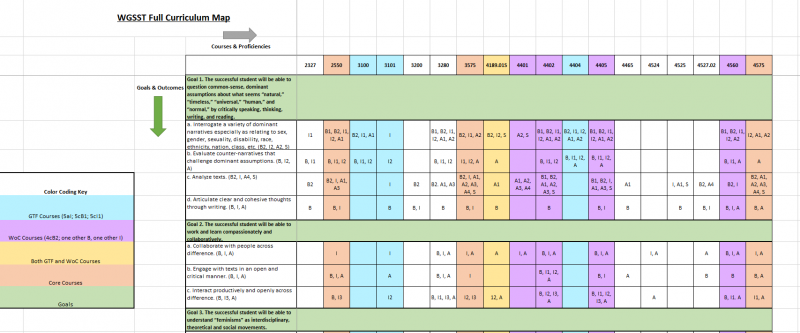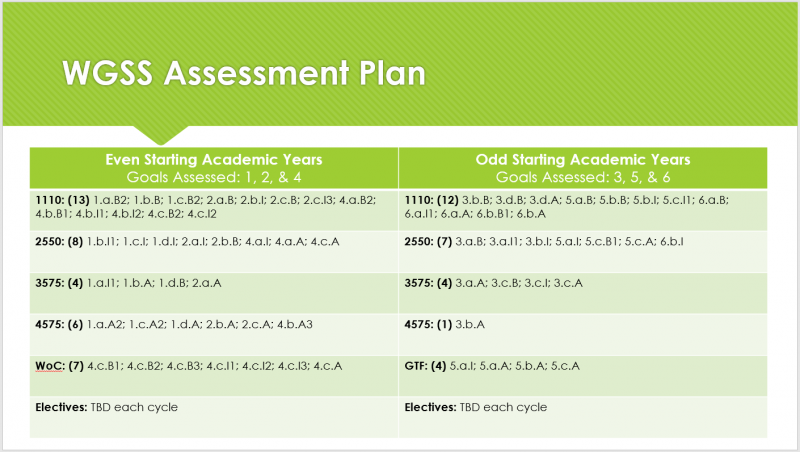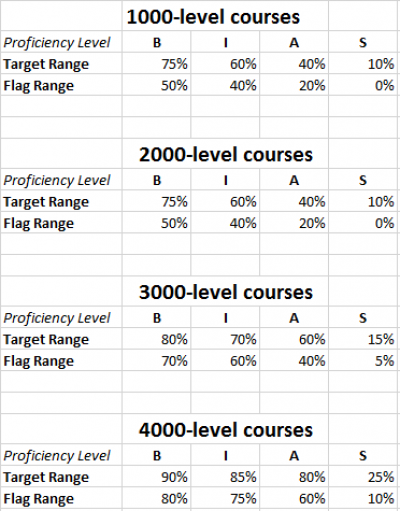The WGSS undergraduate curriculum centers on students engaging with six programmatic goals via an open curriculum model. The goals of the department were created using backwards curriculum design and integrate principles of assessment and iterative development to provide a robust foundation that can adapt to rapid changes in the interdisciplinary field of feminist studies.
The following resources are designed to assist faculty and instructors preparing to teach and assess courses under the curriculum structure.
WGSS Curriculum Resources
Backwards design is a method of course development and instructional design. It focuses on thinking about what learners should demonstrate at the end of the course and works backwards from there. WGSS employs backwards design for its ability to easily integrate curricular goals within individual courses and streamline programmatic assessment while leaving creative freedom and content control in the hands of instructors.
A goal is a large, high level concept learners should grasp by the conclusion of a course or program. In WGSS, our programmatic goals are what we expect majors to master as they work towards their degree. By the end of the program, majors will have engaged with every one of the six department goals.
An outcome is a demonstrable component of a goal. Outcomes take goals and divide them into definitive and demonstrable tasks. When outcomes are demonstrated in tandem, it provides evidence the learner has grasped the goal.
Because outcomes can be demonstrated at variable levels, proficiencies help further define successful learner engagement with an outcome. For example, a major in a 4000-level class who has taken several WGSS classes is expected to engage with outcomes at an advanced proficiency level. Whereas a non-major in a 2000-level class taking the course for a general education requirement is expected to engage with outcomes at a basic proficiency level.
Consider this analogy: goals are finished baked goods (cakes), outcomes are recipes (chocolate, sponge, pineapple upside-down), and proficiencies are the skills you need to execute a recipe (melting chocolate, reducing sugar sauce, releasing a Bundt cake).
To project our tasty analogy to the programmatic level, we can consider the major curriculum to be a baking show while each WGSS course is an individual episode. Episodes build on each other to form the full arch of a season, and in each episode, the bakers have an opportunity to advance their skills through practice.
But what about providing the ingredients used to create recipes or structure of each episode? These are akin to determining content and the backwards course design process. Check out the sections below on backwards design to learn more.
And of course no baking show would be complete without sampling the treats. How do we determine if our WGSS cakes are baked correctly? What do we do if a cake is overbaked or under proved? This is where assessment comes into play. Check out the assessment resources to learn about this step in the process.
At a programmatic level, outcomes and proficiencies are embedded into each course and tracked using a course curriculum map. Individual curriculum maps are combined to create the Full WGSS Curriculum Map, which details the coverage of outcomes and proficiencies across every course in the department. This allows us to see how outcomes and proficiencies are spread across different course levels, visualize if students are able to sequentially progress through the outcomes to master programmatic goals, and spot gaps in our current course offerings. New maps are created and added to the full curriculum map every time a course that has not been mapped before is taught or a new WGSS course is proposed.
The aim of our overarching program structure is that each WGSS major will engage with every outcome of every goal by the time they graduate. Strategic engagement with the WGSS goals informs the major program plan. The major is designed so students encounter all of the goals as they take the four required core courses and accomplish the overarching elective requirements. Because elective requirements are overarching rather than specific, students have a great deal of flexibility in how they complete their major.
The WGSS minor program plan is a simplified version of the major plan. Minors are expected to engage with 3-4 program goals instead of all of them. However the minor is still designed to have students engage with a range of proficiency levels in order to demonstrate high level outcomes. While the minor experience is not as broad as the major, it is designed to be as deep.
WGSS Full Curriculum Map
Here is a snapshot of what the full curriculum map looks like:

The WGSS Full Curriculum Map can only be properly viewed by downloading the excel sheet below.
Course Curriculum Mapping Worksheet
Download the WGSS curriculum mapping worksheet to map a new or existing course to the WGSS curriculum. Email completed sheets to the Academic Program Coordinator for inclusion in the full curriculum map.
Course Design Resources
What is Backwards Design?
Backwards design is a method of course development and instructional design. It focuses on thinking about what learners should demonstrate at the end of the course and works backwards from there.
Whatever educational engagement you're planning (be it a class, a program, or a workshop), backwards design considers the following aspects:
- Define the goals of the experience
- Break the goals down into tangible outcomes and proficiencies
- Determine how the outcomes and proficiencies will be assessed
- Decide what content is needed to practice the outcomes
- Decide what teaching methods and content delivery modes you will use
The next section outlines some key questions to ask as you work through these components of your educational experience.
Key Questions to Ask When Implementing Backwards Design
What are the high level concepts a student should grasp by the end of this course? | Goals
What are the core take away concepts of this class? What knowledges are appropriate for the level of the course? Where does this course fit in the larger WGSS curriculum?
Individual courses have course specific goals as well integrating larger, programmatic goals. At this stage of planning, consider what your course must do to satisfy the needs of the overarching curriculum structure as well as your own goals for the course.
What can I see that shows me the student is engaging with these goals? | Outcomes & Proficiencies
What behaviors would be different? How would students talk, argue, reference, build, write, or create differently than before they learned the material? What actions would they take to demonstrate their knowledge? How could they demonstrate the knowledge at different levels of engagement?
Breaking down high level goals into tangible outcomes and proficiencies asks us to consider what we can see a student do that relays an engagement with the concept and an understanding of the knowledge. Since we can't look directly into students' minds and know for ourselves, we need to carefully consider how they can show us their learning.
What can the student do to practice and demonstrate the course outcomes? | Assessment
How will the student show you they have learned? How will they practice and build the skills necessary to demonstrate their knowledge?
Assessment refers not only to the process of reflecting on a course after it is complete, but to providing students the opportunity to practice their learning and benchmark how they are doing. Assessment methods are windows into how well students are grasping the course outcomes, and by extension the goals. Assessment in the form of discussion, assignments, exams, and final projects provides tangible opportunities to practice the deployment of learned knowledge and see where the gaps are in understanding.
What content do I need to provide in order for the student to practice and demonstrate the knowledge expressed in the outcomes? | Content and teaching methods
What do I need to provide for students to engage with the concepts they'll be practicing? What format and types of information will I use to convey concepts to my students?
Sometimes we inherit a syllabus and teach it without thinking about whether or not the existing content serves what we want to accomplish in the course. Starting with a content driven course can risk losing sight of the purpose for the course and/or include too much extraneous material that does not serve the course. For example, a course on woodchopping does not need to include a vast history of lumberjacking if the course goal is to become a competition level woodchopper. The outcomes for this goal would be based in practicing competitive skills, gaining proper mechanics, and articulating competition rules. However you might want to include the history of lumberjacking as content if the goal of the course is to gain an appreciation for the art of woodchopping. While the history of lumberjacking is content clearly related to woodchopping, the goals of the course drive the necessary content.
Additional Backwards Design Resources
Understanding By Design Framework - Jay Mctighe and Grant Wiggins
Life... In Backwards Design - Jessica Shyu
More information coming soon.
This section will contain information on:
- Cross listed vs. approved related courses
- Course levels and numbering at Ohio State
- Limbo and sun-setting courses
- Links to important curricular information from OSU & ASC
More information coming soon.
This section will contain information on:
- Faculty submission process for permanent new courses
- ABD graduate student submission process for 3320: Special Topics
- Necessary elements for GE and distance learning approval
- Timelines for course submission
- Tips on naming courses for maximum enrollment
Templates & Tools for WGSS Course Design
Links:
WGSS Teaching Repository on Box
Downloads:
Check out the BlendFlex Resource page for information on utilizing BlendFlex teaching methods.
You can also find BlendFlex materials and other distance learning resources on our WGSS Teaching Repository folder in Box.
Check out the Syllabus Elements page for information on required components for OSU and WGSS syllabi.
WGSS Assessment
More information coming soon.
This section will contain information on:
- What is assessment?
- Why does it matter?
- Who is responsible for assessment?
The WGSS Undergraduate Curriculum Assessment Plan
Plan Overview & Cycle
The WGSS curriculum assessment plan will take place over a two-year cycle. A two-year cycle was selected to minimize the time to results while emphasizing a realistic workload for teaching faculty and the undergraduate studies committee tasked with collecting and reviewing assessment data. With a two-year assessment cycle, students who declare their majors as freshman will be captured twice during their anticipated time to degree.
During the first year of the assessment cycle, goals one, two, and four will be assessed. While goals three, five, and six will be assessed during the second year. The goals were split this way across the assessment cycle in order to disperse the labor associated with goals four and five, also known as the “women of color” goal and the “global and transnational feminism” goal, respectively. While goals one, two, three, and six readily appear across the proposed WGSS core courses, the faculty felt goals four and five needed to be reinforced via additional elective courses dedicated to highlighting certain outcomes captured in goals four and five. Goals four and five were thus split across the assessment cycle to balance the additional labor associated with assessing these goals.

Selected Proficiencies
Given the breadth and detail of the goals, outcomes and proficiencies, it was determined to be too much labor to evaluate every proficiency associated with every outcome during the assessment cycle. Instead, we determined representative proficiencies that would minimize the labor per course while maximizing the range of proficiencies assessed for each outcome. Care was taken to select representative proficiencies that emphasize the range of skill level being assessed (a basic, intermediate, and advanced proficiency were selected for each outcome), while also selecting proficiencies that were central to the course in question.
Criteria for Success
Our primary marker of success is for a majority of our students to earn a four out of five, or “above average” on a Likert scale, in each proficiency the encounter in a course with expectations for the percentage of students we aim to hit this marker varying based on course level. Under our new curriculum plan course level should roughly correspond to the number of basic, intermediate, advanced, and specialized proficiencies that are emphasized in each course. For example, a 1000- or 2000-level course should feature mostly basic proficiencies, some intermediate proficiencies, and few advanced proficiencies. Conversely, a 4000-level course should have few basic proficiencies, while concentrating on intermediate and advanced proficiencies. In accordance with class level, we do not anticipate as many students will be successful in hitting the above average mark for the intermediate and advanced proficiencies that appear in lower level courses. Thus expectation on the percentage of a class we wish to achieve an above average designation scales according to class level. This level is noted in figure 5 (also Appendix J) as the “goal” percentage. Similarly, the level at which we become concerned that a class is not demonstrating adequate proficiency scales within each class based on proficiency level and overall based on class level. The minimum marker of success is noted in figure 5 as the “flag” level. Particular attention will be paid to courses where the percentage of students demonstrating above average proficiency fall below this “flag” level.

Rubrics to determine what an above average score look like will be developed on a rolling basis as a collaboration between faculty and the Undergraduate Studies Committee.
To read more about the development of the assessment plan, selecting representative proficiencies, and to view a downloadable version of the assessment criteria by course level, download the WGSS Undergraduate Assessment Plan Overview, Guide to Building the WGSS Assessment Plan, and Assessment Criteria by Course Level excel sheet below.
More information coming soon.
This section will contain information on:
- GE Assessment at Ohio State
- News about the upcoming GE redesign at Ohio State
- Links to current GE courses in the WGSS curriculum
More information coming soon.
This section will contain information on:
- Assessing your course as part of your own review processes
- Assessing your course as part of the department's assessment processes
- The assignment showcase chart
More information coming soon.
This section will contain information on:
- Samples of assignments for in person and distance learning environments
- Sample rubrics
